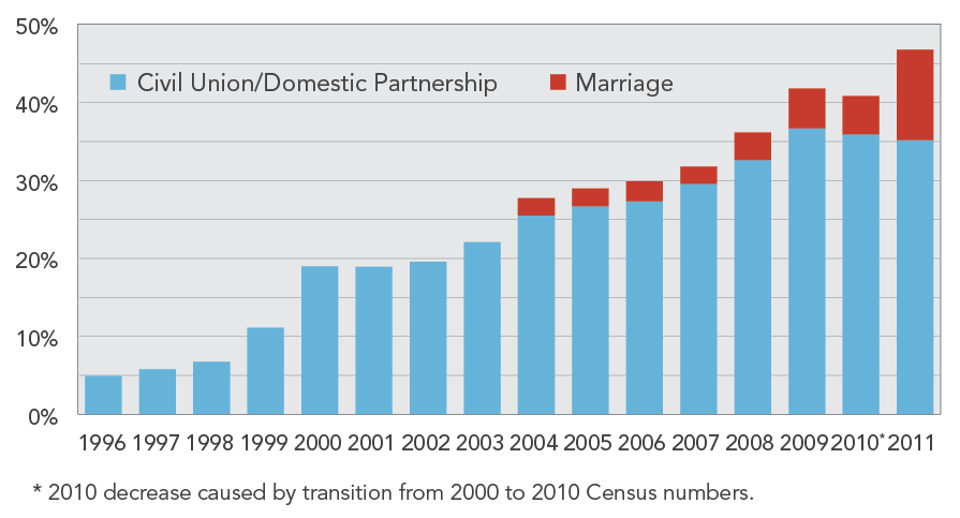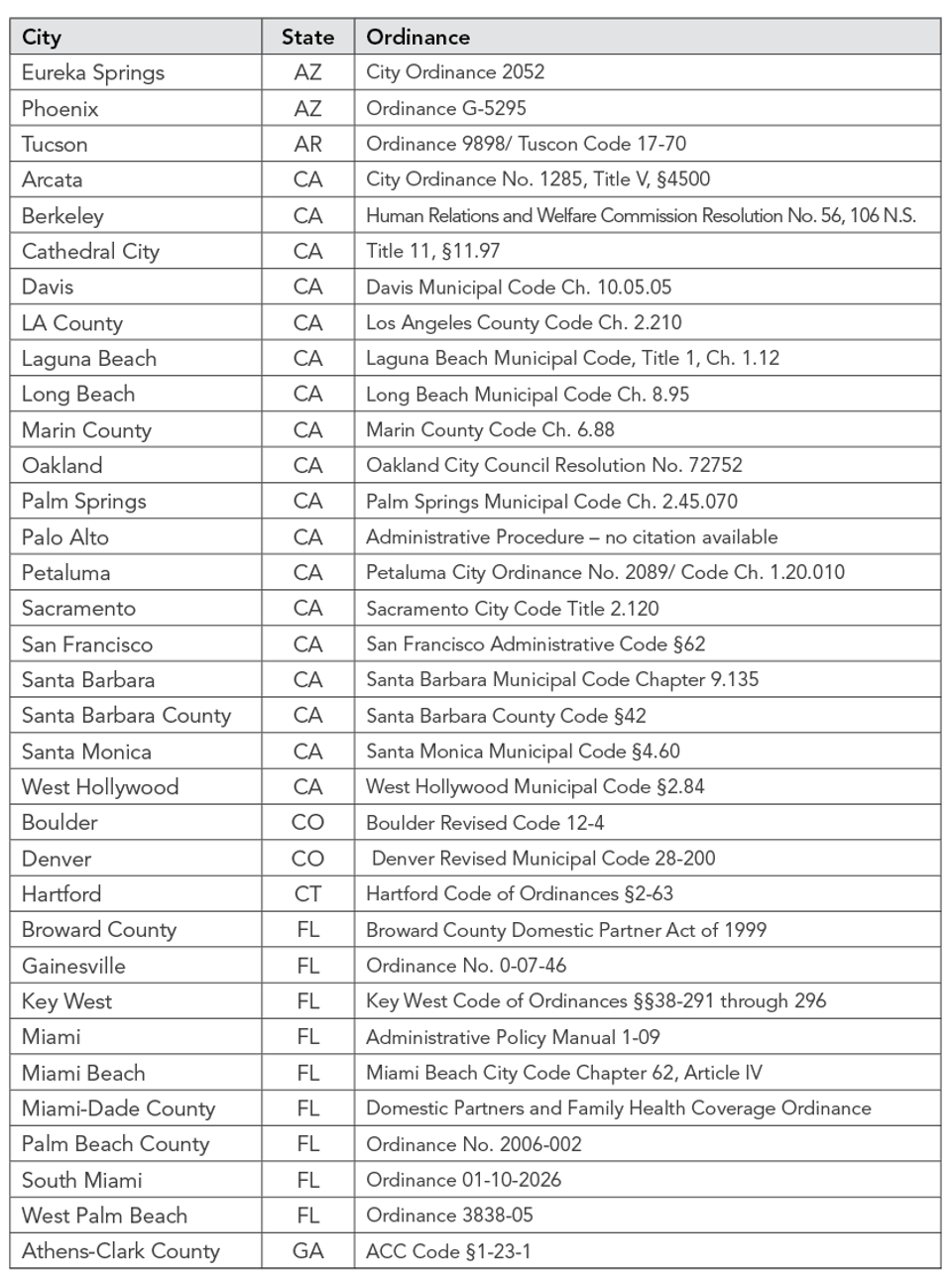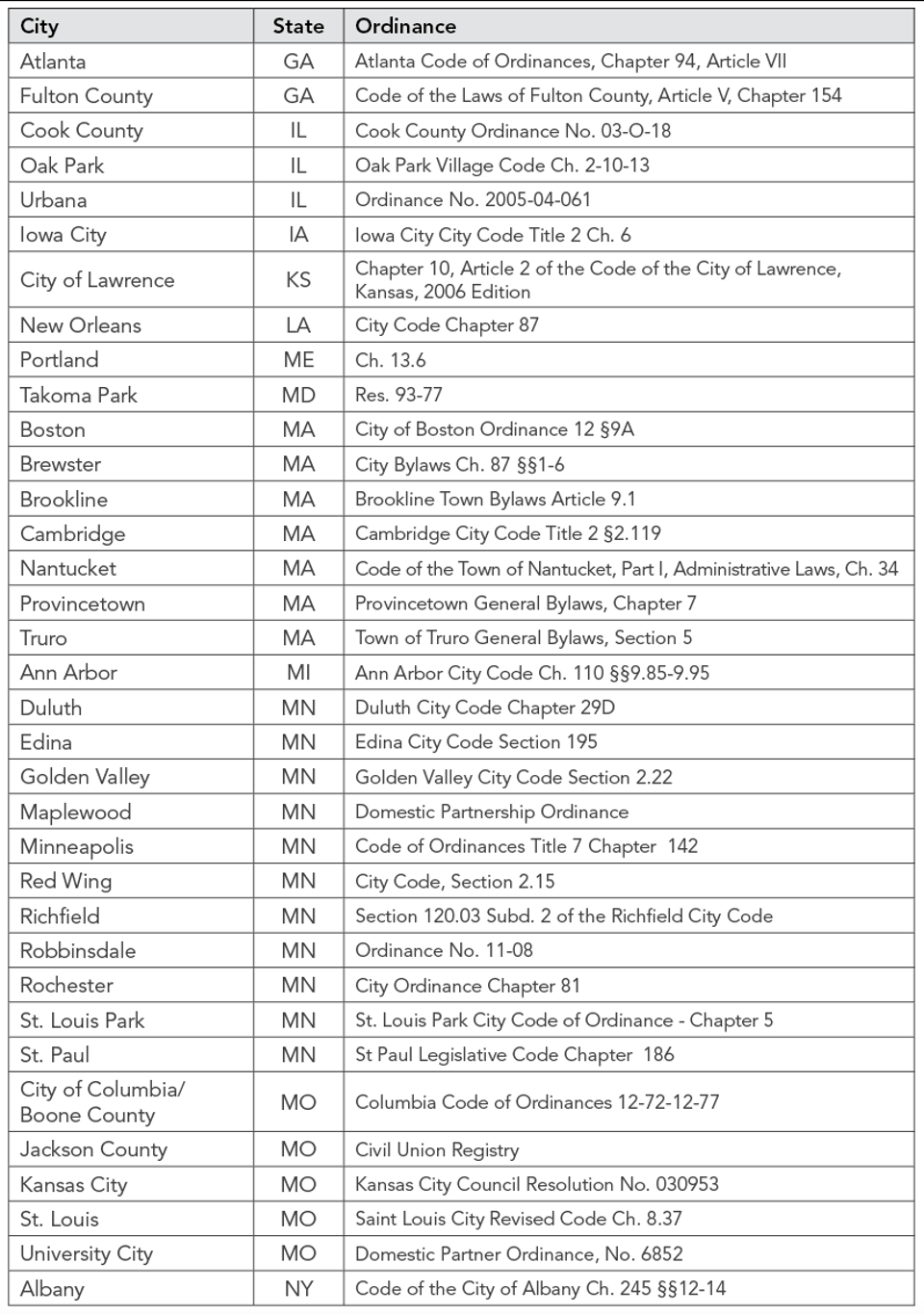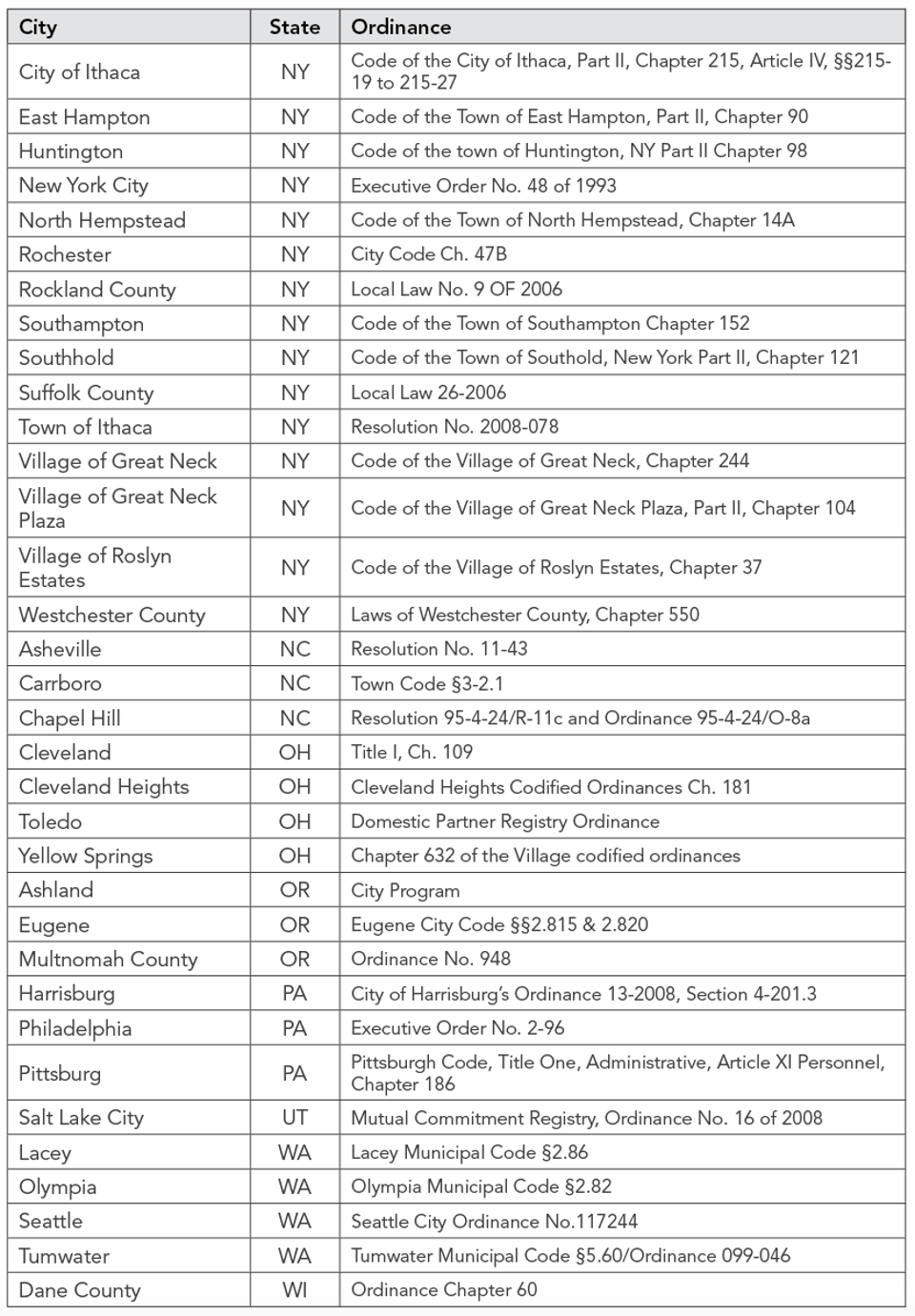Report Published July 22, 2011 · Updated July 22, 2011 · 12 minute read
Then and Now: How the State of Relationship Recognition Has Changed Since DOMA
Lanae Erickson
Fifteen years ago this month, the U.S. House of Representatives passed the so-called Defense of Marriage Act (DOMA).1 The bill, which defined marriage as a union between one man and one woman under federal law, passed by a vote of 342-67—an outcome that roughly reflected public opinion at the time.2 In this report, we go into a drawer and pull out a snapshot of the country’s views and legal stance toward gay couples at the passage of DOMA and compare it to today.
This 15-year old snapshot seems aged beyond its years, reflecting a country whose views have significantly evolved. Five major indicators illustrate the seismic shift between then and now.
- Public support for allowing gay couples to marry has doubled, from 27% to 53%.
- The number of people living in jurisdictions that provide legal recognition to gay couples has leapt more than ten-fold, from 13 million to 143 million.
- The number of states offering protections and benefits to gay state employees and their partners has jumped more than ten-fold, from 2 to 22.
- The number of Fortune 500 companies offering protections and benefits to gay employees and their partners has increased more than fifteen-fold, from 19 to 291 companies.
- A past Democratic President signed DOMA into law; the present Democratic President supports legislation repealing DOMA and has declined to defend the law in court.
These findings demonstrate a remarkable transformation on this issue to the point that it can be argued there is a crystallizing consensus in favor of legal relationship recognition for gay and lesbian couples—extending all the way to marriage in many parts of the country. In 1996, DOMA was thought to have ended the debate on marriage. But it seems to have been only the beginning of a more profound shift in favor of gay and lesbian couples.
Change #1
Americans went from skeptical to accepting of gay and lesbian couples.
When DOMA passed in 1996, many Americans saw gay and lesbian people as outsiders. Now, Americans are far more likely to be accepting and see gay couples as part of the mainstream community. On questions from the definition of a family, to knowing someone who is gay, to whether gay couples should be allowed to marry, our country’s views have shifted dramatically across nearly every demographic group—often by twenty percentage points or more. For example, while only 27% of the country supported marriage for gay couples when DOMA was passed, a solid 53% now support allowing gay couples to marry.3 And while only 42% of Americans knew a gay person in 1992 (1996 numbers are not available), now a full 77% say that they know someone who is gay or lesbian.4
Public Opinion Shift: 1996-Today (Sources 5-95)

Support for relationship recognition, including allowing gay couples to marry, has drastically increased across the entire population, but this change is even starker among certain key demographics. While 53% of the general public now supports marriage for gay couples, 59% of self-described Independents favor it, as do 65% of moderates.6 And although it has long been evident that younger people are generally more supportive of relationship recognition for gay and lesbian couples than older generations, recent polls showing support for marriage at 70% among Americans ages 18-34 illustrate the staggering degree of this difference of viewpoint.7
Even among those who do not yet favor allowing gay couples to marry, there is broad support for legally recognizing those relationships in a significant way. Even as far back as 2008, significant supermajorities of Americans believed gay couples should have protections like inheritance (74%), social security (67%), health insurance (73%), and hospital visitation (86%).8 Those numbers are likely even higher today.
Change #2
Laws recognizing gay couples went from isolated to widespread.
In 1996, only 5% of Americans lived in a state or locality that had any form of legal recognition for gay and lesbian relationships. Today, fully 46.4% of the U.S. population resides in a state or locality with a relationship recognition law.9 This translates to an increase from 13 million to 143 million Americans living in a jurisdiction that recognizes gay couples’ relationships.10
Percentage of U.S. Population Living in Jurisdictions with Relationship Recognition11

Gay and lesbian couples live in every state,12 and in 99.3% of all counties in the United States.13 Together they constitute 1% of all coupled households in the U.S.14 Yet in 1996, not a single state in the country recognized the relationships of gay and lesbian couples.15 A handful of cities had instituted domestic partnership registries within their localities to try to provide some protections to gay couples, but the vast majority of those couples lived in places without any form of legal recognition.16 Today, of the more than 581,000 gay couples living in the United States, 28% are in legally recognized marriage or state equivalent relationships.17 Approximately 9%, or 50,000, of those couples have married in the United States, and up to 5% have married internationally.18 An additional 15% of U.S. gay couples are in legally recognized civil unions.19
Six states plus the District of Columbia now allow gay and lesbian couples to marry, and another 13 have passed civil union or domestic partnership laws that recognize gay couples’ relationships.20 Over 100 cities across the country now have domestic partnership registries, including in states considered very conservative—like Georgia, Missouri, Kansas, and Utah.21
Percentage of U.S. Population Living in Jurisdictions with Relationship Recognition Laws
(Sources 26-3022)

Change #3
Public employee benefits for gay couples went from an anomaly to the norm—even in politically conservative states.
In 1996, only 2 states provided any form of benefits to partners of their gay public employees. Today, nearly half of the states in the country have voluntarily chosen to put their gay employees on equal footing with other workers by offering protections and health care benefits to their domestic partners or spouses. In fact, 49.3 percent of the U.S. population now lives in a state that offers domestic partner protections and benefits to public sector employees.23
Among the public sector, 22 states and the District of Columbia now extend some level of benefits to the partners of their gay public employees: Alaska, Arizona,24 California, Colorado, Connecticut, Hawaii, Illinois, Iowa, Maine, Maryland, Michigan,25 Montana, Nevada, New Jersey, New Mexico, New York, Oregon, Pennsylvania, Rhode Island, Vermont, Washington, and Wisconsin.26 That is a 1000% increase from 1996, when only New York and Vermont offered these benefits.27 In addition, more than 250 cities, counties, and municipalities across the country provide domestic partner benefits to their employees,28 even in red states like Georgia, North Carolina, and Texas.29
States Offering Benefits to Partners of Gay Public Employees30

Change #4
Private sector recognition of gay couples increased from practically nonexistent to virtually standard practice.
Among the private sector, in 1981, not a single employer in the United States extended benefits to domestic partners of their employees.31 By 1996, when DOMA passed, a mere 19 of the Fortune 500 companies offered such benefits.32 By 2011, however, that number had risen to 291.33 Today, more than 80% of Fortune 100 companies, almost two-thirds of Fortune 1000 companies,34 and more than half of all surveyed private sector companies recognize gay couples’ relationships and extend benefits to them.35 Studies show that businesses of all sizes are increasing recognition of gay couples, and the biggest gains are visible amongst large employers.36 As of 2009, 9,374 private, nonprofit, and union employers offered such benefits, and many of these companies assert that offering domestic partner protections to gay workers is useful for recruitment and retention of the best and the brightest employees.37 Across the country, employers both public and private, in every shape and size, are recognizing gay couples’ relationships, and doing so at a rapidly growing pace.
Fortune 500 Companies Offering Benefits to Partners of Gay Employees: 1981-201138

Change #5
Political leaders who once ran away are now running to support gay couples.
In 1996, President Bill Clinton—considered at the time to be the most gay-friendly President in history—signed DOMA into law. Just 15 years later, President Barack Obama has now determined he can see no basis upon which to defend that law in court, and he recently endorsed legislation repealing it. The Obama administration’s decision to cease defending DOMA was announced after proposed laws once considered contentious, like hate crimes protections and the repeal of Don’t Ask, Don’t Tell, skated into law with little controversy under President Obama’s leadership.
On the federal level, President Obama has issued a series of executive actions that would have ignited culture wars in the past:
- Issuing passports to gay couples in their married names, a practice that had previously been forbidden;39
- Ordering the Census Bureau to recognize and count gay couples who were married under state law as married for the purposes of the 2010 Census, a reversal of the previous policy under the Bush administration;40
- Extending protections to domestic partners and spouses of gay Foreign Service employees;41
- Ordering the extension of authorized federal benefits to partners of gay executive branch employees;42
- Extending the scope of the Family and Medical Leave Act (FMLA) to ensure that gay employees will be eligible for leave to care for the children of their partners, even if they have not legally adopted their partner’s children;43 and,
- Enhancing the ability of gay couples to visit and make medical decisions for each other in the hospital by requiring that any hospital accepting Medicaid or Medicare funds allow visitation from and designation of surrogate decision-making power to a gay person’s partner.44
On the state level, Governor Andrew Cuomo of New York led a triumphant, bipartisan effort to make marriage legal for gay and lesbian couples in his state. Rather than casting him as an outlier on social issues, this effort has led to a remarkable national profile of Governor Cuomo as one of the premier new leaders in America.
The dynamic has shifted just as drastically on the opposition side. In 1996, the rhetoric around DOMA was red-hot and vicious. During the House floor debate, the bill’s author Congressman Bob Barr (R-GA) said, “The very foundations of our society are in danger of being burned. The flames of hedonism, the flames of narcissism, the flames of self-centered morality are licking at the very foundations of our society: the family unit.”45
Contrast the reaction of leading opponents to the Obama administration’s announcement in February that it would no longer defend DOMA. As The New York Times observed:
“In the hours that followed, Sarah Palin’s Facebook site was silent. Mitt Romney, the former governor of Massachusetts, was close-mouthed. Tim Pawlenty, the former governor of Minnesota, released a Web video—on the labor union protests in Wisconsin—and waited a day before issuing a marriage statement saying he was ‘disappointed.’ Others, like Newt Gingrich, the former House speaker, and Haley Barbour, the governor of Mississippi, took their time weighing in, and then did so only in the most tepid terms. ‘The Justice Department is supposed to defend our laws,’ Mr. Barbour said.”46
On the Hill, the reaction was similarly muted. Speaker Boehner criticized the move as a distraction: “It is regrettable that the Obama Administration has opened this divisive issue at a time when Americans want their leaders to focus on jobs and the challenges facing our economy.”47 He then accused President Obama of trying to use the issue to his political advantage (something that would have been unthinkable in 1996), saying, “It strikes me as something that’s just as raw politics as anything I’ve seen, knowing that a lot of people who believe in DOMA are probably not likely to vote for him and pandering to the other side on this issue.”48 In contrast to the fire and brimstone of the 1996 debate, these weak protestations seem to indicate that opponents no longer feel it is politically desirable, or even defensible, to use language which demonizes gay people and couples.
Conclusion
Fifteen years ago, President Clinton was seen as leading the most pro-gay administration in our nation’s history. Yet he signed the Defense of Marriage Act, saying, “I have long opposed governmental recognition of same-gender marriages and this legislation is consistent with that position.”49 Fifteen years later, President Clinton said this about New York’s new marriage law.
“Our nation’s permanent mission is to form a ‘more perfect union’—deepening the meaning of freedom, broadening the reach of opportunity, strengthening the bonds of community. That mission has inspired and empowered us to extend rights to people previously denied them. Every time we have done that, it has strengthened our nation. Now we should do it again, in New York, with marriage equality. For more than a century, our Statue of Liberty has welcomed all kinds of people from all over the world yearning to be free. In the 21st century, I believe New York’s welcome must include marriage equality.”50
On DOMA, President Clinton said in 2009, “I changed my position. I am no longer opposed to that. I think if people want to make commitments that last a lifetime, they ought to be able to do it.”51 A number of influential conservatives have made a similar shift, and key leaders like former Solicitor General Ted Olson and former RNC Chairman Ken Mehlman have now added their voices to the chorus of support for allowing gay couples to marry. Even former Republican Congressman Bob Barr, the original author of DOMA, has endorsed its repeal and now supports marriage for gay couples. As these leaders evolve, they seem to be speaking for an entire nation.
Appendix A

Appendix B



